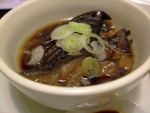Spa Therapies Of Japan
Kanpo (Herbal Medicine):

The Japanese system of herbal medicine, adapted from TCM, is commonly referred to as kanpo. Some of the first kanpo recipes can be found in Japan’s oldest medical text, the ishinpo compiled by Yasuyori Tanba in the 10th century. Today, there are some 150 kanpo recipes listed on the Japanese National Health Insurance Drug Price Tariff. These formulae are often complex and use a wide variety of ingredients. They are gentler than the Chinese recipes, and differ in the finer and smaller quantities used, but are just as effective. The aim of the kanpo practitioner is to balance your ki and in doing so address ailments in all areas of your body. Kanpo may not have any visible effect unless your natural equilibrium is lost; the medicine then acts to re-balance and strengthen your physical system, and activate its self-healing potential – kanpo does not attack the pathogen directly. Kanpo medicine is highly individualised, and the combination of herbs will depend on your constitution, strength, symptoms and resistance to disease. A kanpo formula is tailored to you, not the disease, and designed not only to relieve the symptoms of the disease but to bring you back to health. The herbal remedies are consumed orally, and come in the form of teas or decoctions, or most commonly as pills or granules. Kanpo ingredients may be derived from plants, minerals or animals, although plant ingredients are the most common. They are classified according to their side effects and toxicity; shang pin (upper-class) drugs may not have a strong effect, and have no adverse side effects; zhong pin (middle-class) drugs have weak side effects in small doses or taken over a period of time; and xia pin (lower-class) drugs have strong effects, often accompanied by adverse side effects. The drugs are carefully combined based on long standing formulations so that each acts to create a synergistic effect.
The concept of balance in Japanese cuisine has been influenced by the principles of kanpo. Here’s a simple kanpo recipe you may like to try at home using aubergines. Traditionally aubergines are said to be effective in eliminating fever or loss of appetite. Chilling and serving them with a slightly sour sauce helps increase the appetite. This recipe is recommended for those suffering from high blood pressure or constipation.

Steamed Aubergines In Sour Sauce:
Ingredients:
Seasoning – 3 tbsp Soy sauce; 2 tbsp Sake (Japanese rice wine); 1 tbsp sugar; 1 tbsp vinegar; 3 tbsp hot water;
Steamed Aubergines – 1/2 stalk spring onions (white portion) finely chopped; 1/4 pc ginger grated; a pinch of parsley finely chopped; 7 Japanese aubergines medium.
Mix the seasoning ingredients together, then add the spring onion, ginger and parsley. Chill in the refrigerator. Remove the stems and skin of the aubergines, then steam (preferably in a bamboo steamer) for 15 minutes. Remove the aubergines from the steamer and while hot, squeeze all the liquid from the aubergines. You may wish to put the aubergines on a chopping board and use a tea towel for this purpose or use a rolling pin to squeeze out the liquid initially, but eventually, the finishing touches are best applied by hand. Separate what remains of the aubergines into bite-sized portions using your fingers, length-wise along the natural fibrous grooves of the aubergines. Squeeze dry once more. Roll each piece into a ball, and while the aubergines are still hot, blend in the prepared seasoning sauce. Do this while the aubergines are hot to ensure that the seasoning is absorbed well. Allow the aubergines to cool down to room temperature then put them into the refrigerator. Serve chilled. Make sure the aubergines are well-chilled before serving. Serve in a chilled serving dish.